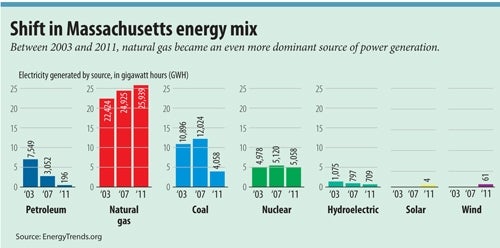Is the energy mix shifting?

The energy sector has a lot of moving parts, and like the grid, they're all interconnected. With new government policies driving a push to clean energy adoption, suppliers of fossil fuel-based energy face their share of challenges in the year ahead. Meanwhile, transitioning to a system based on renewable energy remains an arduous process in a world still powered largely by fossil fuels. This translates into higher energy costs for consumers and businesses, but is there light at the end of the tunnel?
HERE ARE FIVE THINGS TO WATCH IN 2015:
1. More natural gas?
Environmental advocates and concerned residents received good news in December when Tennessee Gas Pipeline Co., a subsidiary of Kinder Morgan, announced it would abandon a plan to run its Northeast Energy Direct natural gas pipeline through undisturbed land across the northern part of the state, choosing instead to shift it a few miles north into southern New Hampshire.
While the project met with resistance from some residents, it's expected to expand natural gas delivery to Central Massachusetts by connecting a distribution center in Dracut with shale fields in Pennsylvania. Despite the route change, delivery capacity for Central Massachusetts will still get a boost from the new pipeline, and Kinder Morgan officials are also looking into building a smaller pipeline in the region. Plans are subject to a lengthy federal review process and a final proposal is expected to be submitted in the fall of 2015. The bottom line for Kinder Morgan is being able to deliver more natural gas, New England's dominant heating source.
2. Rising electricity costs, more affordable renewable energy
Solar power has led the way for renewables in Massachusetts, and as the market has matured, it's become a much more feasible option for consumers and businesses. While the cost of electricity will spike this winter due to limited natural gas capacity, the federal government reported last fall that the cost to install a solar energy system dropped 70 percent in three years.
Meanwhile, the Natural Resources Defense Council has cited industry analysts who predict solar energy rates will fall below retail electricity rates in much of the country by 2018. That's because capital costs for solar energy system manufacturers have decreased as the industry has grown.
And there's reason to expect other renewable energy sources will gain ground. Onshore wind power, for instance, is expected to become competitive with fossil fuel-based sources by next year in Europe, the U.S. and Asia, according to Danish research firm MAKE consulting. That's because technology has advanced to make wind-power machines more efficient.
3. A cap on carbon emissions
Meanwhile, the U.S. Environmental Protection Agency is expected to issue final guidelines for the Clean Power Plan, which will, for the first time, cap carbon emissions from coal plants. Environmentalists say that's long overdue, but the measure has drawn the ire of the coal industry. After the plan was released in June, the American Coal Council issued a statement calling the EPA proposal "another unfortunate chapter in the push to restrict the use of coal in America," and said the rule will have serious negative impacts on economic and social conditions.
The EPA is working with stakeholders ahead of releasing final guidelines for state-by-state compliance, with the goal of cutting 2005 carbon emission levels 30 percent by 2030. Coal plants face costly upgrades to comply with regulations, and those costs will likely be passed on to customers. That, in turn, may encourage wider adoption of clean energy.
4. New energy leadership
One of Governor-elect Charlie Baker's first administrative appointments was Rep. Matthew Beaton, a Shrewsbury Republican and energy efficiency consultant. He will become secretary of Energy and Environmental Affairs, and both he and Baker are expected to continue the quest toward expanded clean energy adoption after Gov. Deval Patrick's administration made a lasting impact in that arena, said Peter Rothstein, president of the New England Clean Energy Council.
Rothstein said Massachusetts, a leader in the use of clean energy, is only about 15 percent of the way through a transition from a fossil-fuel based energy system to one based primarily on "clean" sources such as hydro, solar and wind power. Rothstein said Patrick recognized how to make progress through state programs and legislation, and that Baker and Beaton now have the opportunity to set policies that diversify clean energy and make it more effective and more affordable.
"I think (the Baker administration) will look at clean energy as part of maturing system and encourage competitive innovation ... I think they really get that," Rothstein said.
5. Modernizing the grid
There's a major push at the state and federal levels to modernize the U.S. energy grid, as experts warn that the grid's current infrastructure is vulnerable to natural disasters and terrorism. The dated technology employed by much of the grid system makes it difficult to restore power when there's an outage, and hampers its reliability. The private sector is gradually implementing "smart grid" technology, including computer-based remote control and automation systems, and government efforts to aid that process are in play.
Meanwhile, the U.S. Department of Energy is partnering with industry stakeholders to identify research and development opportunities, while the Massachusetts Department of Public Utilities has ordered large energy providers to submit 10-year grid modernization plans. While total modernization is likely still years away, there will be continued emphasis to meet that goal.









0 Comments